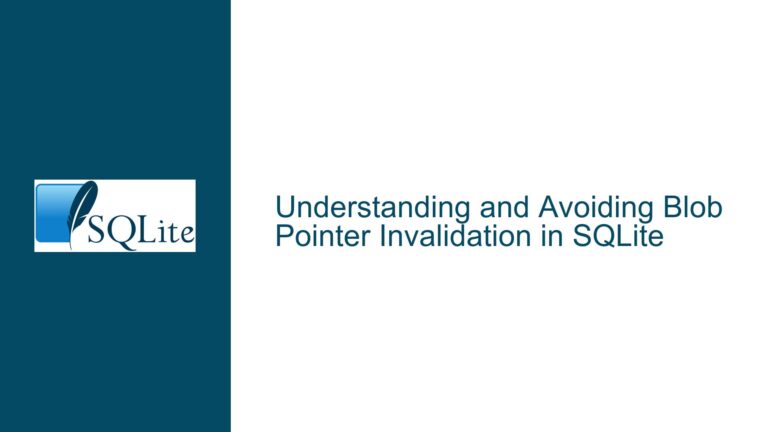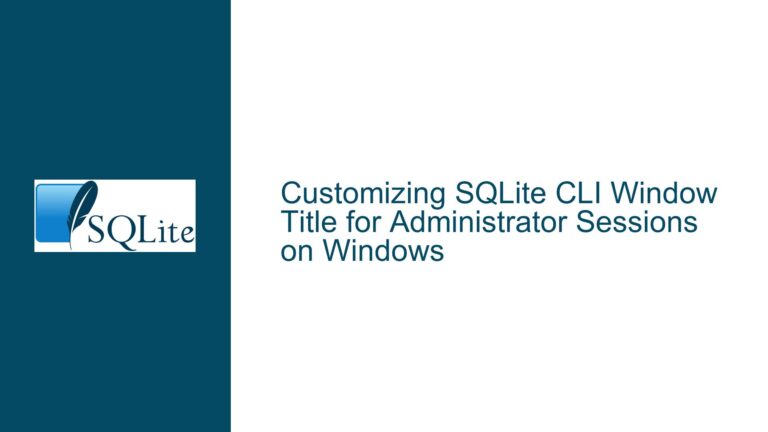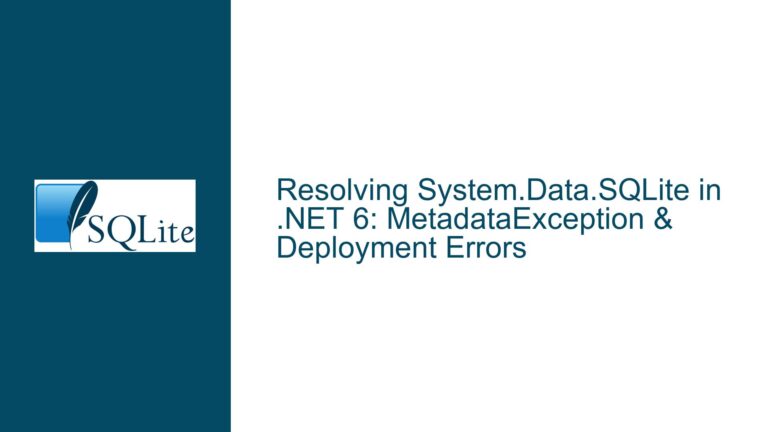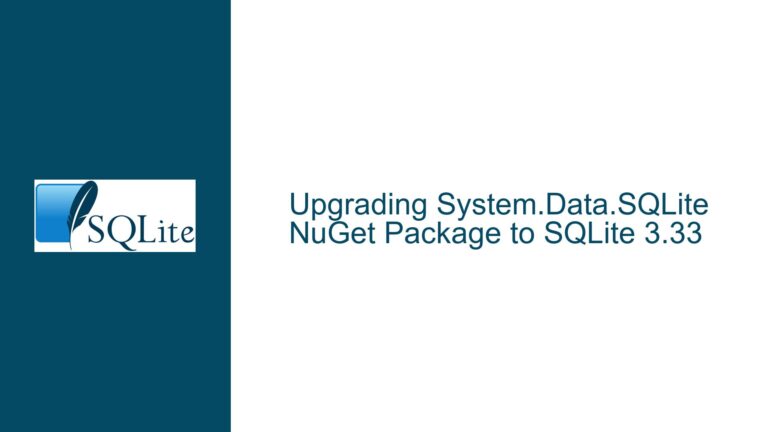Choosing Between SQLite SEE and ZIPVFS for Encrypted Embedded Logging Systems
SQLite SEE vs ZIPVFS: Encryption and Performance Trade-offs for Embedded Logging
When designing an encrypted logging system for embedded platforms using SQLite, the choice between the SQLite Encryption Extension (SEE) and the ZIPVFS extension is critical. Both extensions offer encryption capabilities, but they differ significantly in their design goals, performance characteristics, and suitability for write-heavy workloads like logging. This guide explores the nuances of each extension, their implications for embedded systems, and how to make an informed decision based on your specific requirements.
Embedded Logging Requirements: Encryption, Write Performance, and Fragmentation
Embedded systems often require logging mechanisms that are both efficient and secure. Encryption is a common requirement to protect sensitive log data from unauthorized access. However, encryption is not the only consideration. Write performance is critical in logging systems, as logs are typically written frequently and in real-time. Additionally, database fragmentation can become a concern in embedded systems with limited storage and processing resources.
SQLite SEE is designed specifically for encryption, offering strong security features without compromising write performance. On the other hand, ZIPVFS provides both compression and encryption but is optimized for read-mostly workloads. This design trade-off makes ZIPVFS less suitable for write-heavy logging systems, as it can lead to performance degradation and increased fragmentation over time.
The choice between SEE and ZIPVFS hinges on three key factors: the importance of encryption strength, the frequency of write operations, and the tolerance for database fragmentation. Understanding these factors is essential for selecting the right extension for your embedded logging system.
Weak Encryption in ZIPVFS vs Strong Encryption in SEE
One of the primary differences between ZIPVFS and SEE lies in their encryption capabilities. ZIPVFS uses traditional PKZIP encryption, which is known to be weak and easily broken. This level of encryption may suffice for obfuscation but falls short of providing robust security for sensitive data. In contrast, SEE offers strong encryption algorithms that are designed to meet higher security standards.
The strength of encryption has a direct impact on system performance. Strong encryption, as provided by SEE, requires more computational resources than weak encryption. This can affect both read and write operations, particularly in resource-constrained embedded systems. However, the trade-off is justified if the logs contain sensitive information that requires protection against sophisticated attacks.
ZIPVFS’s weak encryption may be sufficient for non-critical applications where the primary goal is to deter casual inspection rather than prevent determined attacks. However, for systems where data security is paramount, SEE’s strong encryption is the better choice. It is important to evaluate the sensitivity of your log data and the potential risks of unauthorized access when making this decision.
Write Performance and Fragmentation in ZIPVFS
ZIPVFS is optimized for read-mostly workloads, making it less suitable for write-heavy applications like logging. The extension achieves high compression ratios and efficient read performance by trading off write performance. This trade-off can lead to increased database fragmentation, particularly in systems with frequent write operations.
Database fragmentation occurs when data is written in non-contiguous blocks, leading to inefficient storage usage and slower read/write operations. In embedded systems with limited storage and processing power, fragmentation can have a significant impact on performance and longevity. The ZIPVFS documentation explicitly warns about this issue, noting that fragmentation is more likely to occur in write-heavy scenarios.
For logging systems, where data is continuously written, the risk of fragmentation is high. This can result in degraded performance over time, requiring more frequent maintenance and potentially shortening the lifespan of the storage medium. SEE, being designed for general-purpose use, does not suffer from this issue and is better suited for write-heavy workloads.
Key Management: The Overlooked Challenge in Encrypted Logging
While encryption is a critical component of secure logging, key management is often the more challenging aspect. Both SEE and ZIPVFS require effective key management to ensure the security of encrypted data. Poor key management can render even the strongest encryption useless, as compromised keys can provide attackers with access to the encrypted logs.
Key management involves generating, storing, distributing, and rotating encryption keys securely. In embedded systems, this can be particularly challenging due to limited resources and the need for robust security measures. Hardware-based key storage, such as Trusted Platform Modules (TPMs), can provide a secure solution but may not be available in all embedded platforms.
When evaluating SEE and ZIPVFS, it is essential to consider the key management requirements of each extension. SEE’s strong encryption may necessitate more sophisticated key management practices, while ZIPVFS’s weak encryption may be easier to implement but less secure. The choice between the two should take into account the overall security architecture of the system, including key management capabilities.
Performance Implications of Compression in ZIPVFS
Although compression is not a requirement for the logging system in question, it is worth considering the performance implications of enabling compression in ZIPVFS. Compression can reduce storage requirements, which is beneficial in embedded systems with limited storage capacity. However, compression also introduces additional computational overhead, particularly for write operations.
ZIPVFS offers configurable compression levels, including a level 0 option that disables compression entirely. Disabling compression eliminates the associated overhead, making ZIPVFS more comparable to SEE in terms of write performance. However, even with compression disabled, ZIPVFS’s design for read-mostly workloads may still result in suboptimal performance for write-heavy logging systems.
If storage efficiency is a concern, SEE can be paired with external compression tools or libraries to achieve similar results without the performance trade-offs associated with ZIPVFS. This approach allows for greater flexibility in balancing storage efficiency and write performance.
Making the Right Choice: SEE or ZIPVFS for Embedded Logging
The decision to use SEE or ZIPVFS for an encrypted logging system in an embedded environment depends on a careful evaluation of the system’s requirements and constraints. SEE is the better choice for systems that prioritize strong encryption and write performance, particularly when log data is sensitive and write operations are frequent. ZIPVFS, while offering encryption and compression, is better suited for read-mostly workloads and may not meet the performance and security needs of a write-heavy logging system.
When making this decision, consider the following factors:
- The sensitivity of the log data and the required level of encryption.
- The frequency and volume of write operations.
- The potential impact of database fragmentation on system performance and longevity.
- The system’s key management capabilities and overall security architecture.
- The availability of storage and computational resources.
By carefully weighing these factors, you can select the extension that best meets the needs of your embedded logging system, ensuring both security and performance.
Implementing SEE for Encrypted Logging in SQLite
If you decide to use SEE for your encrypted logging system, the implementation process involves several key steps. First, you need to obtain and install the SEE extension, which requires a license from the SQLite Consortium. Once installed, you can enable encryption for your SQLite database by specifying an encryption key during database creation or opening.
The encryption key must be managed securely, as it is essential for both encrypting and decrypting the database. SEE supports multiple encryption algorithms, allowing you to choose the one that best meets your security requirements. It is important to test the performance impact of encryption on your specific hardware to ensure that it meets the system’s real-time logging requirements.
In addition to enabling encryption, you should implement robust key management practices to protect the encryption key from unauthorized access. This may involve using hardware security modules (HSMs), secure boot processes, or other mechanisms to ensure the integrity and confidentiality of the key.
Mitigating Fragmentation in Write-Heavy Logging Systems
For systems that require frequent write operations, database fragmentation can be a significant concern. While SEE does not inherently cause fragmentation, the nature of logging systems can still lead to fragmented databases over time. To mitigate this issue, consider implementing periodic maintenance routines that optimize the database and reduce fragmentation.
SQLite provides several tools and techniques for managing fragmentation, including the VACUUM command, which rebuilds the database file to remove unused space and consolidate data. Regular use of VACUUM can help maintain optimal performance and storage efficiency in write-heavy logging systems.
Additionally, you can configure SQLite’s auto-vacuum mode to automatically reclaim unused space after deletions. This can help reduce the need for manual maintenance and ensure that the database remains efficient over time.
Conclusion: Balancing Security and Performance in Embedded Logging
Designing an encrypted logging system for an embedded platform requires careful consideration of both security and performance. SQLite SEE and ZIPVFS offer different trade-offs in terms of encryption strength, write performance, and database fragmentation. By understanding these trade-offs and evaluating your system’s specific requirements, you can make an informed decision that ensures both the security and efficiency of your logging system.
SEE is generally the better choice for write-heavy logging systems that require strong encryption, while ZIPVFS may be suitable for read-mostly workloads with less stringent security requirements. Regardless of the extension you choose, effective key management and regular database maintenance are essential for maintaining the security and performance of your embedded logging system.






